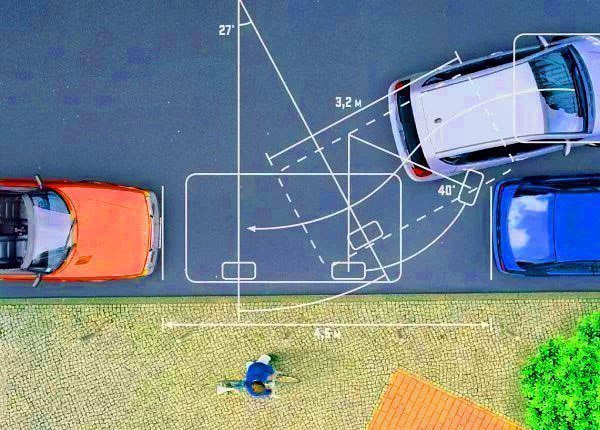
Parallel Parking for Dummies: Tips and Step-by-Step Instructions
Updated Nov. 20, 2020Despite being one of the most dreaded driving maneuvers, parallel parking can be surprisingly easy – when you know how it works. There is no denying that parallel parking is harder than both angle parking and perpendicular parking, though like all things, it can be mastered with practice.
Don’t be one of those drivers who would sooner waste an hour searching for a space than attempt to parallel park. Use the guidance outlined here and you can be a parallel parking pro! Most state driving handbooks do not explain parallel parking in detail, so we have broken down the maneuver into an easy-to-follow, step-by-step guide.
Parallel parking step-by-step
Keep in mind that the instructions provided here are generally applicable. You may need to adjust reference points based on the size of your vehicle, how it handles and the specific parallel parking situation.
ALWAYS practice parallel parking in an empty parking lot before attempting it on the road between real vehicles. Cones or flags can be set up 25 feet apart to show where other cars would sit. When you can parallel park in an empty lot without hitting these markers, you are ready to try it for real.
- 1

Look for an appropriate space.
Make sure you choose a space that your vehicle can fit in. Keep in mind that you will need extra maneuvering room when first attempting to parallel park. Check that there are no “NO PARKING” signs which would make parking in your chosen spot illegal. - 2

Signal your intention to turn.
Use your right signal light or a right-turn hand signal to tell other drivers you have claimed this parking space. - 3

Stop when your car is lined-up with the vehicle beyond your space.
Your driving handbook may recommend leaving two feet of space, though this is usually too large a gap when parking on the right. Try to stop as close to the other vehicle as possible. - 4

Shift your car into “reverse” and look for traffic.
When checking for traffic you must use your mirrors AND turn your head to check the vehicle’s blind spots. Leave your signal light on to let other drivers know not to pull up close behind you. It may sometimes be necessary to wave a motorist past if they do not realize you intend to turn. - 5

Reverse cautiously.
Only begin to back up once you are certain it is safe to do so. - 6

Steer sharply to the right when your rear wheels clear the rear bumper of the adjacent vehicle.
Turn the steering wheel completely to the right and hold it in that position while continuing to reverse. - 7

Continue until your vehicle is at a 45-degree angle in relation to the curb.
You should be in the correct position when your front wheels are lined up with the rear of the vehicle in front. The right side-view mirror can also be used as a reference point, when it is in-line with the bumper of the vehicle in front. In extremely tight parking spots, drivers can check their position with the headlights of the vehicle behind. You should be roughly at the right angle when you can see both headlights in your left side-view mirror. Note that this will not work if the vehicle behind you is too far away. - 8

Straighten your wheels and reverse in a straight line.
Stop when your right side-view mirror is in line with the left corner of the car in front. - 9

Steer sharply to the left.
Continue reversing into the parking space but stop before you collide with the vehicle behind you. - 10

Shift the car into “drive”, straighten up and pull forward.
Center the vehicle in the parking space. Make sure you do not hit the curb and that no part of your vehicle is sticking out into the traffic lane. Try to leave an equal amount of space between your vehicle and the vehicles to the front and rear.
You are bound to feel pretty excited having successfully parallel parked for the first time! If you are leaving your vehicle, be sure not to neglect proper protocol. Make sure the parking brake is active and exit the vehicle with care.
Parallel parking tips
Our parallel parking tips can help you get to grips with parallel parking in the shortest possible time, while ensuring the experience stress-free.
- Start at the beginning.
Do not attempt to learn parallel parking until you are comfortable with car reference points, backing up in general, angle parking and 90-degree parking. Without these skills, you will be in over your head. - Take your time.
You may feel rushed when parallel parking next to real cars for the first time, but it is important to take things slowly. Moving slowly will let you utilize your reference points more effectively and stop without damaging other vehicles, if you maneuver incorrectly. - Ask for help, if you need it.
If you know a licensed driver who is confident with parallel parking, ask them to accompany you while you are learning. - Practice regularly.
This is the best advice you will receive. You will learn much faster attempting to parallel park than reading guides and watching videos. You will make mistakes – but this is all part of the process! Each time you go wrong will take you one step closer to doing it right.
How to pull out from parallel parking
Thankfully, pulling out of a parallel parking spot is much easier than getting in to start with. Though, it can still be a challenge. Follow these guidelines to drive out of a parallel parking spot:
- 1

Make sure your wheels are straight.
Slowly reverse toward the vehicle behind you while looking in your mirrors and over your right shoulder. Take care not to back up too far. - 2

Turn your head and use your mirrors to check all around the vehicle for approaching motorists, cyclists and pedestrians.
- 3

Signal your intention to move into the traffic lane, using your rear-view mirror to keep an eye out for hazards.
- 4

Turn your head to look over your left shoulder, steer left and begin to drive forward when it is safe.
Look toward the front of your vehicle to make sure you can clear the car ahead of you. - 5

Check again for hazards by turning to look over your left shoulder.
Drive forward and align yourself in the traffic lane when it is safe.




